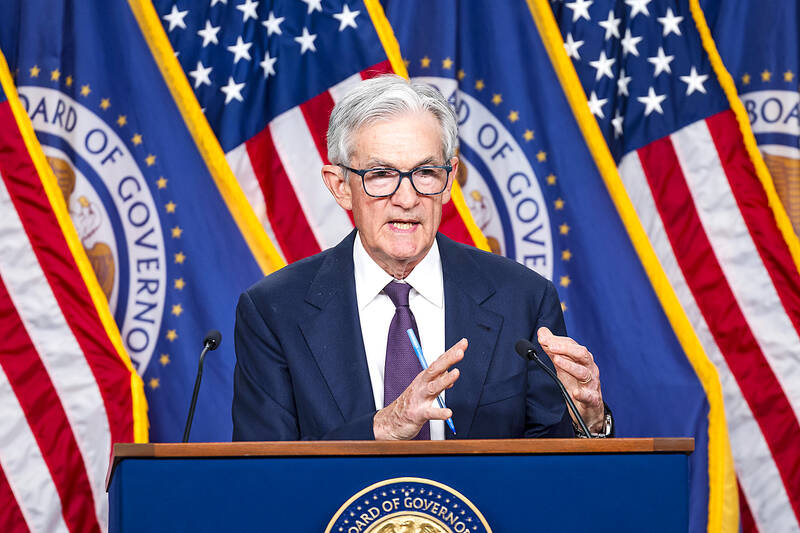The US Federal Reserve on Wednesday announced another pause in rate cuts, and warned of higher risks to its inflation and unemployment goals in a likely reference to US President Donald Trump’s tariff rollout.
Policymakers voted unanimously to hold the US central bank’s key lending rate at between 4.25 percent and 4.50 percent, the Fed said in a statement.
Wall Street stocks closed higher following the Fed’s decision. Asian and European markets mostly rose yesterday ahead of weekend tariff talks between China and the US, with London boosted by reports that a “major trade deal” flagged by Trump was with the UK.

Photo: EPA-EFE
The “hard” economic data published in recent weeks points toward an economic slowdown, while the unemployment rate has hovered close to historic lows and inflation has trended toward the Fed’s 2 percent target.
However, the “softer” economic survey data have pointed to a sharp drop-off in consumer confidence and growing expectations of higher inflation over the longer term — in contrast to the market’s inflation expectations, which remain relatively well-anchored.
Speaking to reporters in Washington after the US central bank’s decision was published, US Federal Reserve Chair Jerome Powell said there was “a great deal of uncertainty” about where the Trump administration’s tariff policies would end up.
Trump’s moves have sent shivers through world markets, fueled fears of a global recession and speculation of a reordering of decades-old trading norms.
“If the large increases in tariffs that have been announced are sustained, they’re likely to generate a rise in inflation, a slowdown in economic growth and an increase in unemployment,” Powell said.
“The effects on inflation could be short-lived, reflecting a one-time shift in the price level,” he said, adding that it was “possible that the inflationary effects could instead be more persistent.”
The Fed in its post-meeting statement said that “uncertainty about the economic outlook has increased further,” and that the chances of higher unemployment and inflation had also risen.
Powell was also asked about public criticism leveled at him and the Fed by senior government officials — including the US president, who has called for him to cut rates to boost economic growth.
An upbeat Powell said Trump’s criticism did not affect the Fed’s job of tackling inflation and unemployment “at all.”
“We are always going to consider only the economic data, the outlook, the balance of risks, and that’s it,” he said.
Analysts do not expect the Fed to move until July at the earliest.
“Recent job data, including last Friday’s non-farm payroll, indicate solid momentum, allowing the Fed to maintain its current stance,” JPMorgan Asset Management chief Asia market strategist Tai Hui (許長泰) said. “With only one more set of job data expected before the June 17-18 meetings, the likelihood of a rate cut in June is low. The Fed aims to assert its independence amidst pressure from President Trump to reduce rates, requiring significant deterioration in hard data to justify a cut.”

WEAKER ACTIVITY: The sharpest deterioration was seen in the electronics and optical components sector, with the production index falling 13.2 points to 44.5 Taiwan’s manufacturing sector last month contracted for a second consecutive month, with the purchasing managers’ index (PMI) slipping to 48, reflecting ongoing caution over trade uncertainties, the Chung-Hua Institution for Economic Research (CIER, 中華經濟研究院) said yesterday. The decline reflects growing caution among companies amid uncertainty surrounding US tariffs, semiconductor duties and automotive import levies, and it is also likely linked to fading front-loading activity, CIER president Lien Hsien-ming (連賢明) said. “Some clients have started shifting orders to Southeast Asian countries where tariff regimes are already clear,” Lien told a news conference. Firms across the supply chain are also lowering stock levels to mitigate

Six Taiwanese companies, including contract chipmaker Taiwan Semiconductor Manufacturing Co (TSMC, 台積電), made the 2025 Fortune Global 500 list of the world’s largest firms by revenue. In a report published by New York-based Fortune magazine on Tuesday, Hon Hai Precision Industry Co (鴻海精密), also known as Foxconn Technology Group (富士康科技集團), ranked highest among Taiwanese firms, placing 28th with revenue of US$213.69 billion. Up 60 spots from last year, TSMC rose to No. 126 with US$90.16 billion in revenue, followed by Quanta Computer Inc (廣達) at 348th, Pegatron Corp (和碩) at 461st, CPC Corp, Taiwan (台灣中油) at 494th and Wistron Corp (緯創) at

NEGOTIATIONS: Semiconductors play an outsized role in Taiwan’s industrial and economic development and are a major driver of the Taiwan-US trade imbalance With US President Donald Trump threatening to impose tariffs on semiconductors, Taiwan is expected to face a significant challenge, as information and communications technology (ICT) products account for more than 70 percent of its exports to the US, Chung-Hua Institution for Economic Research (CIER, 中華經濟研究院) president Lien Hsien-ming (連賢明) said on Friday. Compared with other countries, semiconductors play a disproportionately large role in Taiwan’s industrial and economic development, Lien said. As the sixth-largest contributor to the US trade deficit, Taiwan recorded a US$73.9 billion trade surplus with the US last year — up from US$47.8 billion in 2023 — driven by strong

ASE Technology Holding Co (ASE, 日月光投控), the world’s biggest chip assembly and testing service provider, yesterday said it would boost equipment capital expenditure by up to 16 percent for this year to cope with strong customer demand for artificial intelligence (AI) applications. Aside from AI, a growing demand for semiconductors used in the automotive and industrial sectors is to drive ASE’s capacity next year, the Kaohsiung-based company said. “We do see the disparity between AI and other general sectors, and that pretty much aligns the scenario in the first half of this year,” ASE chief operating officer Tien Wu (吳田玉) told an